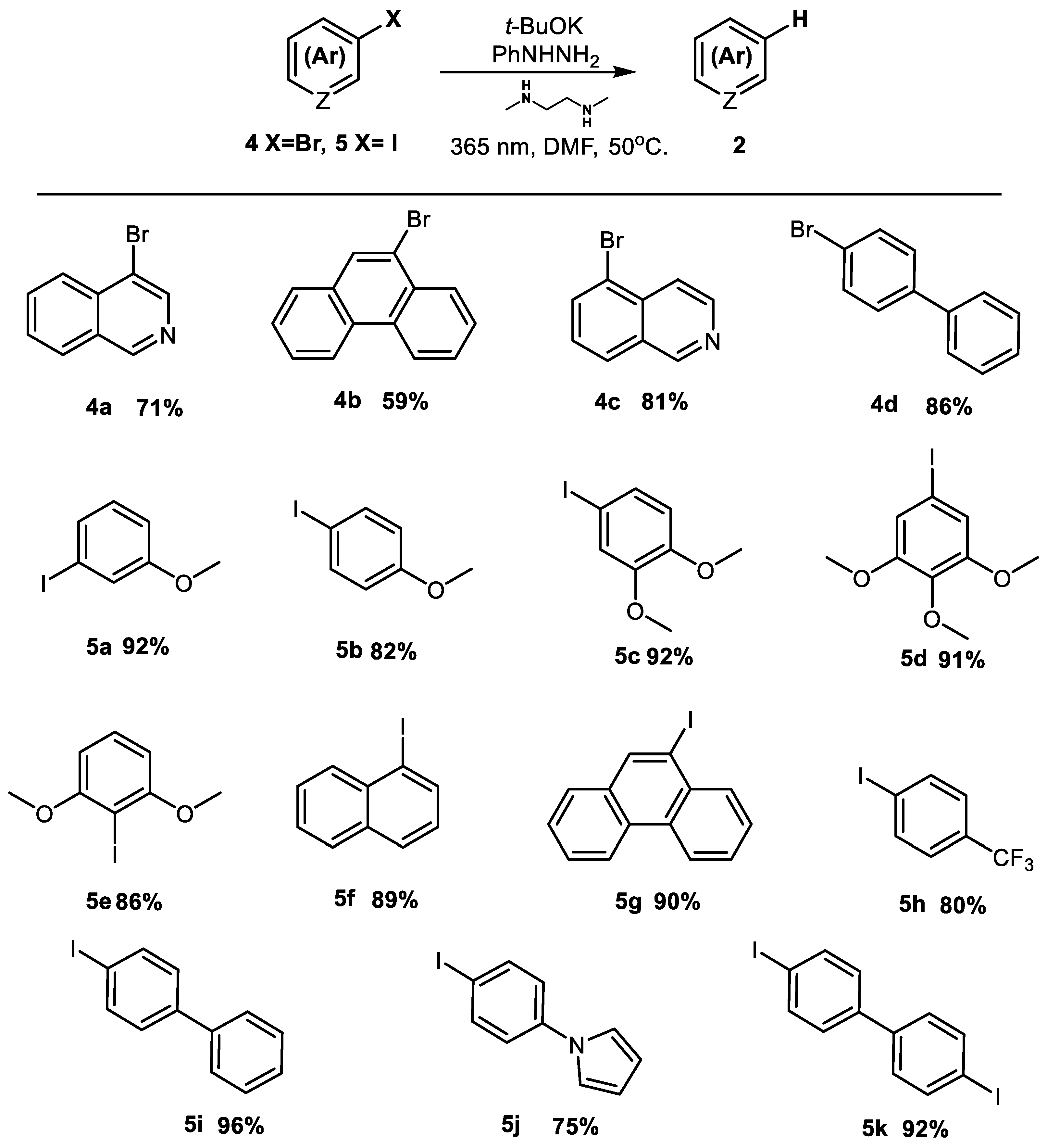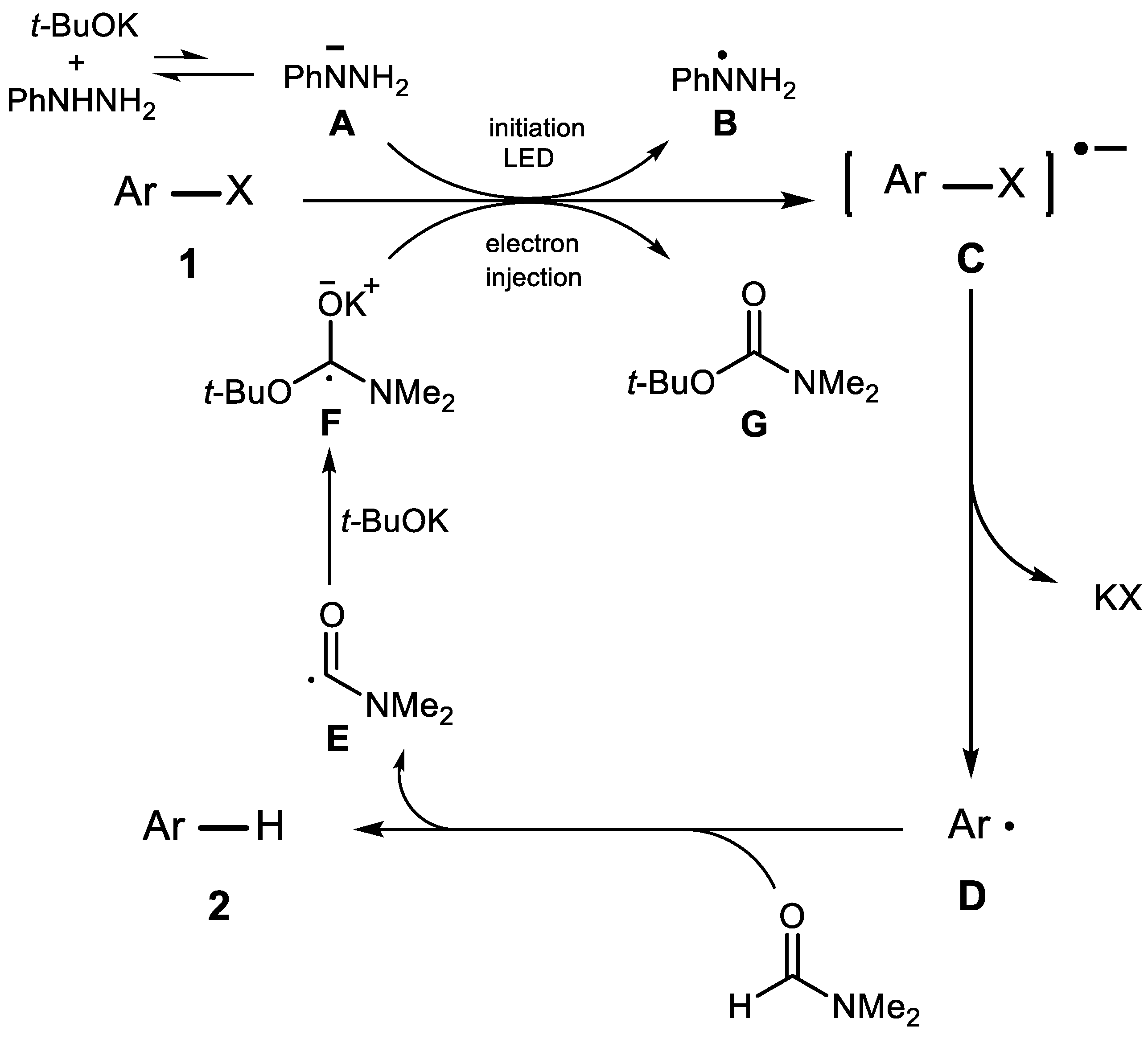Photo-Induced, Phenylhydrazine-Promoted Transition-Metal-Free Dehalogenation of Aryl Fluorides, Chlorides, Bromides, and Iodides
Abstract
:1. Introduction
2. Results and Discussion
3. Conclusions
4. Materials and Methods
4.1. General Information
4.2. Procedure for the Deiodination of 4-chloro-1,1′-biphenyl
4.3. General Procedure for the Reduction of C−X Bond
Supplementary Materials
Author Contributions
Funding
Institutional Review Board Statement
Informed Consent Statement
Data Availability Statement
Acknowledgments
Conflicts of Interest
Sample Availability
References
- Fukuzumi, S.; Kotani, H.; Ohkubo, K.; Ogo, S.; Tkachenko, N.V.; Lemmetyinen, H. Electron-transfer state of 9-mesityl-10-methylacridinium ion with a much longer lifetime and higher energy than that of the natural photosynthetic reaction center. J. Am. Chem. Soc. 2004, 126, 1600–1601. [Google Scholar] [CrossRef]
- Sadowsky, D.; McNeill, K.; Cramer, C.J. Dehalogenation of aromatics by nucleophilic aromatic substitution. Environ. Sci. Technol. 2014, 48, 10904–10906. [Google Scholar] [CrossRef] [PubMed]
- Harrad, S.; Robson, M.; Hazrati, S.; Baxter-Plant, V.S.; Deplanche, K.; Redwood, M.D.; Macaskie, L.E. Dehalogenation of polychlorinated biphenyls and polybrominated diphenyl ethers using a hybrid bioinorganic catalyst. J. Environ. Monit. 2007, 9, 314. [Google Scholar] [CrossRef] [PubMed]
- Mitoma, Y.; Nagashima, S.; Simion, C.; Simion, A.M.; Yamada, T.; Mimura, K.; Ishimoto, K.; Tashiro, M. Dehalogenation of aromatic halides using metallic calcium in ethanol. Environ. Sci. Technol. 2001, 35, 4145. [Google Scholar] [CrossRef]
- Hites, R.A. Environmental behavior of chlorinated dioxins and furans. Acc. Chem. Res. 1990, 23, 194. [Google Scholar] [CrossRef]
- Bhattacharjya, A.; Klumphu, P.; Lipshutz, B. Ligand-Free, Palladium-Catalyzed Dihydrogen Generation from TMDS: Dehalogenation of aryl halides on water. Org. Lett. 2015, 17, 1122. [Google Scholar] [CrossRef]
- Pyo, A.; Kim, S.; Kumar, M.R.; Byeun, A.; Eom, M.S.; Han, M.S.; Lee, S. Palladium-catalyzed hydrodehalogenation of aryl halides using paraformaldehyde as the hydride source: High-throughput screening by paper-based colorimetric iodide sensor. Tetrahedron Lett. 2013, 54, 5207. [Google Scholar] [CrossRef]
- Zawisza, A.M.; Muzart, J. Pd-catalyzed reduction of aryl halides using dimethylformamide as the hydride source. Tetrahedron Lett. 2007, 48, 6738. [Google Scholar] [CrossRef]
- Liu, W.; Hou, F. Transition-metal-free dehalogenation of aryl halides promoted by phenanthroline/potassium tert-butoxide. Tetrahedron 2017, 73, 931. [Google Scholar] [CrossRef]
- Ueno, R.; Shimizu, T.; Shirakawa, E. Reduction of aryl halides into arenes with 2-propanol promoted by a substoichiometric amount of a tert-butoxy radical source. Synlett 2016, 27, 741. [Google Scholar] [CrossRef]
- Ong, D.Y.; Tejo, C.; Xu, K.; Hirao, H.; Chiba, S. Hydrodehalogenation of haloarenes by a sodium hydride–iodide composite. Angew. Chem. Int. Ed. 2017, 56, 1840. [Google Scholar] [CrossRef] [PubMed]
- Dewanji, A.; Mück-Lichtenfeld, C.; Studer, A. Radical hydrodeiodination of aryl, alkenyl, alkynyl, and alkyl iodides with an alcoholate as organic chain reductant through electron catalysis. Angew. Chem. Int. Ed. 2016, 55, 6749. [Google Scholar] [CrossRef] [PubMed]
- Cao, D.-W.; Yan, C.-X.; Zhou, P.-P.; Zeng, H.-Y.; Li, C.-J. Hydrogen bonding promoted simple and clean photo-induced reduction of C–X bond with isopropanol. Chem. Commun. 2019, 55, 767. [Google Scholar] [CrossRef] [PubMed]
- Fukuyama, T.; Fujita, Y.; Miyoshi, H.; Ryu, I.; Kao, S.-C.; Wu, Y.-K. Electron transfer-induced reduction of organic halides with amines. Chem. Commun. 2018, 54, 5582. [Google Scholar] [CrossRef] [PubMed]
- Jiang, H.; Bak, J.R.; Loópez-Delgado, F.J.; Jørgensen, K.A. Practical metal-and additive-free methods for radical-mediated reduction and cyclization reactions. Green Chem. 2013, 15, 3355. [Google Scholar] [CrossRef]
- Kawamoto, T.; Ryu, I. Radical reactions of borohydrides. Org. Biomol. Chem. 2014, 12, 9733. [Google Scholar] [CrossRef]
- Dichiarante, V.; Fagnoni, M.; Albini, A. Eco-friendly hydrodehalogenation of electron-rich aryl chlorides and fluorides by photochemical reaction. Green Chem. 2009, 11, 942–945. [Google Scholar] [CrossRef]
- Gair, J.J.; Grey, R.L.; Giroux, S.; Brodney, M.A. Palladium catalyzed hydrodefluorination of fluoro-(hetero) arenes. Org. Lett. 2019, 21, 2482. [Google Scholar] [CrossRef]
- Shon, J.H.; Kim, D.; Teets, T.S. Photoredox catalysis on unactivated substrates with strongly reducing iridium photosensitizers. Chem. Sci. 2021, 12, 4069–4078. [Google Scholar] [CrossRef]
- Yang, Z.S.; Tang, W.X.; Chen, X.Y. Electron donor–acceptor complex enabled cascade reaction of unprotected o-anilide aryl chlorides for heterocycle synthesis. Org. Chem. Front. 2023, 10, 1219–1223. [Google Scholar] [CrossRef]
- Dam, B.; Sahoo, A.K.; Patel, B.K. Visible-light-mediated synthesis of β-keto sulfones using g-C3N 4 as a recyclable photocatalyst under sustainable conditions. Green Chem. 2022, 24, 7122–7130. [Google Scholar] [CrossRef]
- Mäsing, F.; Nu, H.; Klingauf, J.; Studer, A. Light mediated preparation of palladium nanoparticles as catalysts for alkyne cis-semihydrogenation. Org. Lett. 2017, 19, 2658. [Google Scholar]
- Liu, X.; Wang, J.C.; Dong, G.B. Modular entry to functionalized tetrahydrobenzo[b]azepines via the palladium/norbornene cooperative catalysis enabled by a C7-modified norbornene. J. Am. Chem. Soc. 2021, 143, 9991–10004. [Google Scholar] [CrossRef] [PubMed]
- Studer, A.; Curran, D.P. Catalysis of radical reactions: A radical chemistry perspective. Angew. Chem. Int. Ed. 2016, 55, 58. [Google Scholar] [CrossRef] [PubMed]
- Studer, A.; Curran, D.P. The electron is a catalyst. Nat. Chem. 2014, 6, 765. [Google Scholar] [CrossRef]
- Studer, A.; Curran, D.P. Organocatalysis and C-H activation meet radica- and electron-transfer reactions. Angew. Chem. Int. Ed. 2011, 50, 5018. [Google Scholar] [CrossRef]
- Drapeau, M.P.; Fabre, I.; Grimaud, L.; Ciofini, I.; Ollevier, T.; Taillefer, M. Transition-metal-free α-arylation of enolizable aryl ketones and mechanistic evidence for a radical process. Angew. Chem. Int. Ed. 2015, 54, 10587. [Google Scholar] [CrossRef]
- Boyle, W.J., Jr.; Bunnett, J.F. Relative reactivities of methanol and methoxide ion as hydrogen atom donors to the p-nitrophenyl radical. J. Am. Chem. Soc. 1974, 96, 1418. [Google Scholar] [CrossRef]
- Kawamoto, T.; Sato, A.; Ryu, I. Photoinduced aminocarbonylation of aryl iodides. Chem. Eur. J. 2015, 21, 14764. [Google Scholar] [CrossRef]
- Mäsing, F.; Mardyukov, A.; Doerenkamp, C.; Eckert, H.; Malkus, U.; Nüsse, H.; Klingauf, J.; Studer, A. Controlled light-mediated preparation of gold nanoparticles by a norrish type i reaction of photoactive polymers. Angew. Chem. Int. Ed. 2015, 54, 12612. [Google Scholar]
- Mäsing, F.; Wang, X.; Nüsse, H.; Klingauf, J.; Studer, A. Facile light-mediated preparation of small polymer-coated palladium-nanoparticles and their application as catalysts for alkyne semi-hydrogenation. Chem. Eur. J. 2017, 23, 6014. [Google Scholar]
- MacKenzie, I.A.; Wang, L.; Onuska, N.P.R.; Williams, O.F.; Begam, K.; Moran, A.M.; Dunietz, B.D.; Nicewicz, D.A. Discovery and characterization of an acridine radical photoreductant. Nature 2020, 580, 76–80. [Google Scholar] [CrossRef]
- Venditto, N.J.; Liang, Y.S.; El Mokadem, R.K.; Nicewicz, D.A. Ketone–olefin coupling of aliphatic and aromatic carbonyls catalyzed by excited-state acridine radicals. J. Am. Chem. Soc. 2022, 144, 11888–11896. [Google Scholar] [CrossRef]
- Lu, Y.; Wu, C.; Hou, J.; Wu, Z.; Zhou, M.; Huang, X.; He, W. Ferrocene-mediated photocatalytic annulation of n-sulfonyl ketimines on a polycrystalline wse2 semiconductor photocatalyst. ACS Catal. 2023, 13, 13071–13076. [Google Scholar] [CrossRef]
- Xu, H.; Li, X.; Ma, J.; Zuo, J.; Song, X.; Lv, J.; Yang, D. Visible-light-induced synthesis of thioethers through three-component reactions of α-diazoesters, thiols, and cyclic ethers. Chin. Chem. Lett. 2023, 34, 108403. [Google Scholar] [CrossRef]
- Song, H.; Xiao, F.; Jiang, J.; Wu, C.; Ji, H.; Lu, Y.; Wang, K.; He, W. External photocatalyst-free CH alkylation of N-sulfonyl ketimines with alkanes under visible light. Chin. Chem. Lett. 2023, 34, 108509. [Google Scholar] [CrossRef]
- Yuan, J.; Liu, Y.; Ge, Y.; Dong, S.; Song, S.; Yang, L.; Xiao, Y.; Zhang, S.; Qu, L. Visible-light-induced regioselective ortho-c—h phosphonylation of β-naphthols with diarylphosphine oxides. Chin. J. Org. Chem. 2021, 12, 4738–4748. [Google Scholar] [CrossRef]
- Zeng, F.; Zhu, H.; Wang, R.; Yuan, X.; Sun, K.; Qu, L.; Chen, X.; Yu, B. Bismuth vanadate: A versatile heterogeneous catalyst for photocatalytic functionalization of C(sp2)-H bonds. Chin. J. Catal. 2023, 46, 157–166. [Google Scholar] [CrossRef]






| Entry | x | Light Source | T (°C) | Base | Solvent | Yield (%) b |
|---|---|---|---|---|---|---|
| 1 | 0 | 365 nm | 50 | 4eq. t-BuOK + 8eq. Et3N | DMF | 6 |
| 2 | 1 | 365 nm | 50 | 4eq. t-BuOK + 8eq. Et3N | DMF | 13 |
| 3 | 2 | 365 nm | 50 | 4eq. t-BuOK + 8eq. Et3N | DMF | 29 |
| 4 | 4 | 365 nm | 50 | 4eq. t-BuOK + 8eq. Et3N | DMF | 83 |
| 5 | 6 | 365 nm | 50 | 4eq. t-BuOK + 8eq. Et3N | DMF | 72 |
| 6 | 4 | 365 nm | 50 | 4eq. t-BuOK + 8eq. Et3N | MeCN | 38 |
| 7 | 4 | 365 nm | 50 | 4eq. t-BuOK + 8eq. Et3N | 1,4-Dioxane | 15 |
| 8 | 4 | 365 nm | 50 | 4eq. t-BuOK + 8eq. Et3N | t-BuOH | 19 |
| 9 | 4 | 254 nm | 50 | 4eq. t-BuOK + 8eq. Et3N | DMF | 21 |
| 10 | 4 | 395 nm | 50 | 4eq. t-BuOK + 8eq. Et3N | DMF | 42 |
| 11 | 4 | 405 nm | 50 | 4eq. t-BuOK + 8eq. Et3N | DMF | 62 |
| 12 | 4 | 455 nm | 50 | 4eq. t-BuOK + 8eq. Et3N | DMF | 35 |
| 13 | 4 | 485 nm | 50 | 4eq. t-BuOK + 8eq. Et3N | DMF | 38 |
| 14 | 4 | Dark | 50 | 4eq. t-BuOK + 8eq. Et3N | DMF | 7 |
| 15 | 4 | 365 nm | 50 | 4eq. t-BuOK | DMF | 26 |
| 16 | 4 | 365 nm | 50 | 8eq. Et3N | DMF | 8 |
| 17 | 4 | 365 nm | 50 | 8eq. t-BuOK + 16eq. Et3N | DMF | 88 |
| 18 | 4 | 365 nm | 50 | 8eq. t-BuOK + 16eq. N,N,N′,N′-Tetramethylethylenediamine | DMF | 92 |
| 19 | 4 | 365 nm | 50 | 8eq. t-BuOK + 16eq. N,N′-Dimethyl-1,2-ethanediamine | DMF | 95 |
| 20 | 4 | 365 nm | 35 | 8eq. t-BuOK + 16eq. N,N′-Dimethyl-1,2-ethanediamine | DMF | 42 |
Disclaimer/Publisher’s Note: The statements, opinions and data contained in all publications are solely those of the individual author(s) and contributor(s) and not of MDPI and/or the editor(s). MDPI and/or the editor(s) disclaim responsibility for any injury to people or property resulting from any ideas, methods, instructions or products referred to in the content. |
© 2023 by the authors. Licensee MDPI, Basel, Switzerland. This article is an open access article distributed under the terms and conditions of the Creative Commons Attribution (CC BY) license (https://creativecommons.org/licenses/by/4.0/).
Share and Cite
Zhu, Y.; Wu, Z.; Sun, H.; Ding, J. Photo-Induced, Phenylhydrazine-Promoted Transition-Metal-Free Dehalogenation of Aryl Fluorides, Chlorides, Bromides, and Iodides. Molecules 2023, 28, 6915. https://doi.org/10.3390/molecules28196915
Zhu Y, Wu Z, Sun H, Ding J. Photo-Induced, Phenylhydrazine-Promoted Transition-Metal-Free Dehalogenation of Aryl Fluorides, Chlorides, Bromides, and Iodides. Molecules. 2023; 28(19):6915. https://doi.org/10.3390/molecules28196915
Chicago/Turabian StyleZhu, Yiwei, Zhimin Wu, Hongcai Sun, and Junjun Ding. 2023. "Photo-Induced, Phenylhydrazine-Promoted Transition-Metal-Free Dehalogenation of Aryl Fluorides, Chlorides, Bromides, and Iodides" Molecules 28, no. 19: 6915. https://doi.org/10.3390/molecules28196915




